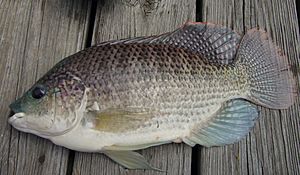Oreochromis aureus facts for kids
Quick facts for kids Oreochromis aureus |
|
|---|---|
 |
|
| Conservation status | |
| Scientific classification | |
| Synonyms | |
|
The blue tilapia (Oreochromis aureus) is a type of tilapia fish. It belongs to the Cichlidae family. This fish is originally from Northern and Western Africa, and the Middle East. However, people have moved it to many other places. Now, it lives in parts of the United States. Here, it is known as an invasive species. This means it can cause big problems for the environment. In South Africa, it is called blue kurper.
Contents
About the Blue Tilapia
Blue tilapia in the United States usually grow to be about 13 to 20 centimeters (5 to 8 inches) long. They can weigh up to 2.3 to 2.7 kilograms (5 to 6 pounds). The biggest one ever found was over 53 centimeters (21 inches) long. It weighed more than 4.5 kilograms (10 pounds).
Reproduction and Diet
Blue tilapia are mouthbrooders. This means the female fish carries her eggs and young in her mouth. A female can lay between 160 and 1600 eggs at a time.
These fish mainly eat plants. But sometimes, they also eat tiny water animals called zooplankton. Young blue tilapia also eat small creatures without backbones.
Where Do Blue Tilapia Live?
The blue tilapia naturally lives in Northern and Western Africa, and the Middle East. In Africa, you can find them in rivers like the Senegal, Niger, Benue, and the lower Nile. In the Middle East, they live in the Jordan River.
People have moved blue tilapia to many new places. You can now find them in the United States. They live in states like Texas, Alabama, Florida, and Nevada. They have also spread to Central and South America, and Southeast Asia. The first blue tilapia brought to the United States came from Israel.
Habitat Conditions
Blue tilapia mostly live in fresh water and slightly salty water, called brackish water. They can be found in many places like streams, rivers, lakes, and ponds. They can even live in very salty water, up to 4.5% salt. For comparison, seawater is about 3.5% salt.
They prefer water temperatures between 12 and 32 degrees Celsius (54 to 90 degrees Fahrenheit). But they can handle temperatures from 8 to 40 degrees Celsius (46 to 104 degrees Fahrenheit).
Blue Tilapia as an Invasive Species
An invasive species is a plant or animal that is not native to an area. When it is introduced, it can harm the environment. Oreochromis aureus has been brought to many parts of the world. People often introduced them to be used as food. They also used them to help control water plants.
Sometimes, people confused blue tilapia with another fish, Oreochromis niloticus. This is because the two species look very similar. Scientists only recently learned how to tell them apart.
Impact in the United States
The blue tilapia was first brought to Florida in 1961. Since then, it has spread a lot. It is now the most common non-native fish in Florida. It lives as far north as Lake Alice in Gainesville.
This fish causes big problems for the National Park Service. It is very common in Taylor Slough in Everglades National Park. Here, it has changed the types of fish that live there. The species is also spreading in Texas. It once caused problems for largemouth bass in Lake Trinidad. It is also linked to a decrease in native mussels in two Texas lakes. In Warm Springs Natural Area, Nevada, it is blamed for a big drop in native fish populations.
See also
 In Spanish: Oreochromis aureus para niños
In Spanish: Oreochromis aureus para niños


